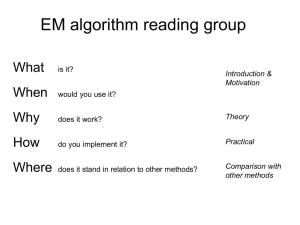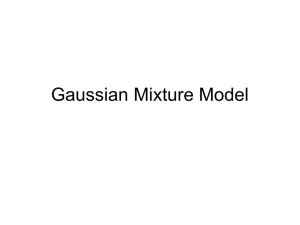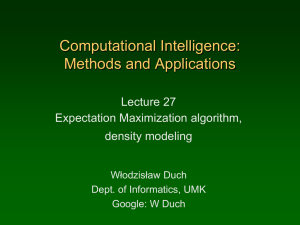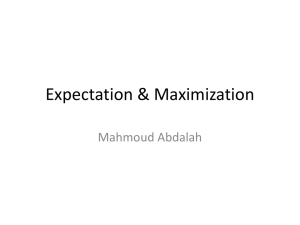Maximum Likelihood (ML), Expectation Maximization
advertisement
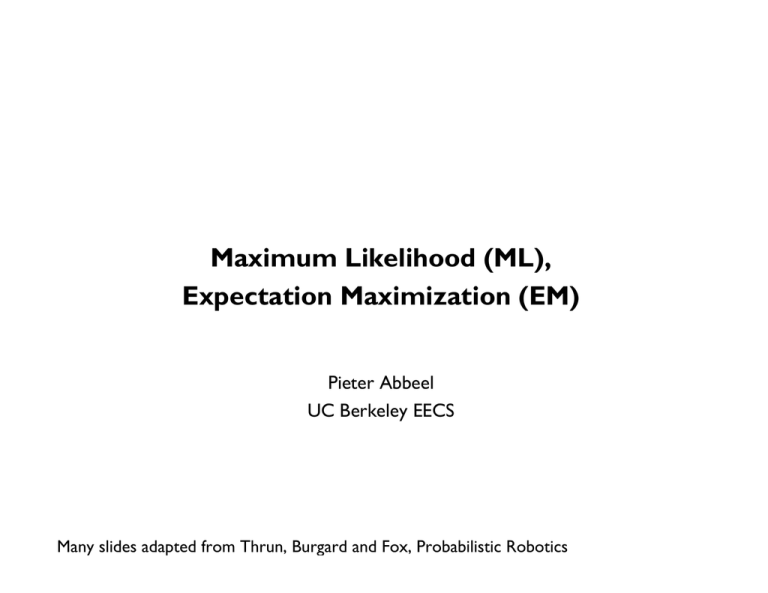
Maximum Likelihood (ML), Expectation Maximization (EM) Pieter Abbeel UC Berkeley EECS Many slides adapted from Thrun, Burgard and Fox, Probabilistic Robotics Outline n Maximum likelihood (ML) n Priors, and maximum a posteriori (MAP) n Cross-validation n Expectation Maximization (EM) Thumbtack n Let µ = P(up), 1-µ = P(down) n How to determine µ ? n Empirical estimate: 8 up, 2 down à n http://web.me.com/todd6ton/Site/Classroom_Blog/Entries/2009/10/7_A_Thumbtack_Experiment.html Maximum Likelihood n µ = P(up), 1-µ = P(down) n Observe: n Likelihood of the observation sequence depends on µ: n Maximum likelihood finds à extrema at µ = 0, µ = 1, µ = 0.8 à Inspection of each extremum yields µML = 0.8 Maximum Likelihood n More generally, consider binary-valued random variable with µ = P(1), 1-µ = P(0), assume we observe n1 ones, and n0 zeros n Likelihood: n Derivative: n Hence we have for the extrema: n n n1/(n0+n1) is the maximum = empirical counts. Log-likelihood n The function is a monotonically increasing function of x n n n Hence for any (positive-valued) function f: In practice often more convenient to optimize the loglikelihood rather than the likelihood itself Example: Log-likelihood ßà Likelihood n Reconsider thumbtacks: 8 up, 2 down n Likelihood Not Concave n n n log-likelihood Concave Definition: A function f is concave if and only Concave functions are generally easier to maximize then non-concave functions Concavity and Convexity f is convex if and only f is concave if and only x1 ¸ x2+(1-¸)x2 “Easy” to maximize x2 x1 ¸ x2+(1-¸)x2 “Easy” to minimize x2 ML for Multinomial n Consider having received samples ML for Fully Observed HMM n Given samples n Dynamics model: n Observation model: à Independent ML problems for each and each ML for Exponential Distribution Source: wikipedia n Consider having received samples n 3.1, 8.2, 1.7 ll ML for Exponential Distribution Source: wikipedia n Consider having received samples n Uniform n Consider having received samples n ML for Gaussian n Consider having received samples n ML for Conditional Gaussian Equivalently: More generally: ML for Conditional Gaussian ML for Conditional Multivariate Gaussian Aside: Key Identities for Derivation on Previous Slide ML Estimation in Fully Observed Linear Gaussian Bayes Filter Setting n Consider the Linear Gaussian setting: n Fully observed, i.e., given n à Two separate ML estimation problems for conditional multivariate Gaussian: n 1: n 2: Priors --- Thumbtack n Let µ = P(up), 1-µ = P(down) n How to determine µ ? n ML estimate: 5 up, 0 down à n Laplace estimate: add a fake count of 1 for each outcome Priors --- Thumbtack n Alternatively, consider µ to be random variable n Prior P(µ) / µ(1-µ) n Measurements: P( x | µ ) n Posterior: n Maximum A Posterior (MAP) estimation n = find µ that maximizes the posterior à Priors --- Beta Distribution Figure source: Wikipedia Priors --- Dirichlet Distribution n Generalizes Beta distribution n MAP estimate corresponds to adding fake counts n1, …, nK MAP for Mean of Univariate Gaussian n Assume variance known. (Can be extended to also find MAP for variance.) n Prior: MAP for Univariate Conditional Linear Gaussian n n Assume variance known. (Can be extended to also find MAP for variance.) Prior: [Interpret!] MAP for Univariate Conditional Linear Gaussian: Example TRUE --Samples . ML --MAP --- Cross Validation n Choice of prior will heavily influence quality of result n Fine-tune choice of prior through cross-validation: n 1. Split data into “training” set and “validation” set n 2. For a range of priors, n n n 3. Choose prior with highest validation score n n Train: compute µMAP on training set Cross-validate: evaluate performance on validation set by evaluating the likelihood of the validation data under µMAP just found For this prior, compute µMAP on (training+validation) set Typical training / validation splits: n n 1-fold: 70/30, random split 10-fold: partition into 10 sets, average performance for each of the sets being the validation set and the other 9 being the training set Outline n Maximum likelihood (ML) n Priors, and maximum a posteriori (MAP) n Cross-validation n Expectation Maximization (EM) Mixture of Gaussians n Generally: n Example: n ML Objective: given data z(1), …, z(m) n Setting derivatives w.r.t. µ, µ, § equal to zero does not enable to solve for their ML estimates in closed form We can evaluate function à we can in principle perform local optimization. In this lecture: “EM” algorithm, which is typically used to efficiently optimize the objective (locally) Expectation Maximization (EM) n Example: n Model: n Goal: n n n n Given data z(1), …, z(m) (but no x(i) observed) Find maximum likelihood estimates of µ1, µ2 EM basic idea: if x(i) were known à two easy-to-solve separate ML problems EM iterates over n n E-step: For i=1,…,m fill in missing data x(i) according to what is most likely given the current model µ M-step: run ML for completed data, which gives new model µ EM Derivation n EM solves a Maximum Likelihood problem of the form: µ: parameters of the probabilistic model we try to find x: unobserved variables z: observed variables Jensen’s Inequality Jensen’s inequality Illustration: P(X=x1) = 1-¸, P(X=x2) = ¸ x1 x2 E[X] = ¸ x2+(1-¸)x2 EM Derivation (ctd) Jensen’s Inequality: equality holds when is an affine function. This is achieved for EM Algorithm: Iterate 1. E-step: Compute 2. M-step: Compute M-step optimization can be done efficiently in most cases E-step is usually the more expensive step It does not fill in the missing data x with hard values, but finds a distribution q(x) EM Derivation (ctd) n n n M-step objective is upperbounded by true objective M-step objective is equal to true objective at current parameter estimate à Improvement in true objective is at least as large as improvement in M-step objective EM 1-D Example --- 2 iterations n Estimate 1-d mixture of two Gaussians with unit variance: n n one parameter µ ; µ1 = µ - 7.5, µ2 = µ+7.5 EM for Mixture of Gaussians n X ~ Multinomial Distribution, P(X=k ; µ) = µk n Z ~ N(µk, §k) n Observed: z(1), z(2), …, z(m) EM for Mixture of Gaussians n E-step: n M-step: ML Objective HMM n Given samples n Dynamics model: n Observation model: n ML objective: à à No simple decomposition into independent ML problems for each and each No closed form solution found by setting derivatives equal to zero EM for HMM --- M-step n à µ and ° computed from “soft” counts EM for HMM --- E-step n No need to find conditional full joint n Run smoother to find: ML Objective for Linear Gaussians n Linear Gaussian setting: n Given n ML objective: n EM-derivation: same as HMM EM for Linear Gaussians --- E-Step n Forward: n Backward: EM for Linear Gaussians --- M-step [Updates for A, B, C, d. TODO: Fill in once found/derived.] EM for Linear Gaussians --- The Log-likelihood n When running EM, it can be good to keep track of the loglikelihood score --- it is supposed to increase every iteration EM for Extended Kalman Filter Setting n n As the linearization is only an approximation, when performing the updates, we might end up with parameters that result in a lower (rather than higher) log-likelihood score à Solution: instead of updating the parameters to the newly estimated ones, interpolate between the previous parameters and the newly estimated ones. Perform a “line-search” to find the setting that achieves the highest log-likelihood score
